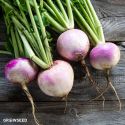 Autumn King is the allotment favourite. Its substantial, tapered roots can reach up to 30cm (12″) in length, and they possess the unique ability to endure winter without the risk of splitting. Featuring a brilliant orange hue with a red core, these roots are tapered and broad-shouldered, making them not only visually appealing but also delectable.
Autumn King is the allotment favourite. Its substantial, tapered roots can reach up to 30cm (12″) in length, and they possess the unique ability to endure winter without the risk of splitting. Featuring a brilliant orange hue with a red core, these roots are tapered and broad-shouldered, making them not only visually appealing but also delectable.
Whether in the kitchen garden or showcased on exhibition grounds, Autumn King carrots deliver beauty, flavour, and abundant yields.
True to its name, this late-maturing carrot is best planted in summer to ensure a bountiful storage crop for the winter months.
Recipient of the Royal Horticultural Society Award of Garden Merit, this variety comes with the recognition of its exceptional qualities.
Carrot Tips
Carrot seeds are very small and light so avoid sowing on windy days. Sow thinly to avoid waste, which can be difficult for less experienced growers – mixing the seed with fine horticultural sand for sowing can help avoid over-sowing.
Keep seeds damp after sowing by misting or watering with a very fine rose.
Some growers like to cover rows with a plank for a week after direct sowing to avoid drying out whilst the seed germinates but beware of slugs and snails.
Chitting, pre-germination, will give your carrots a great start. Take a clean piece of flat boarding and moisten it. Now spread out the Carrot seed on this, making sure, as far as possible, that one seed does not touch another, A large darning needle is an ideal tool for separating them when you have laid them out on the board.
Now set the board on a sunny window-ledge or in some similar position. See that the board is kept damp but never too wet. A mister spray is useful for this. After a few days you will see the seed beginning to germinate and can sow.
Germination will be slow at low temperatures and may take as long as 21 days. Covering with horticultural fleece or cloche will improve germination by increasing the temperature. Optimum germination temperatures over 10ºC but warmer is better.
I wouldn’t recommend starting in modules or pots and transplanting. Most often this results in distorted, multi-legged carrots.
There’s more on Growing Carrots here





Reviews
There are no reviews yet.